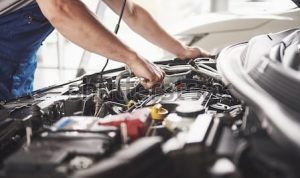
The relationship between a vehicle owner, a repair facility and the Technician working on their vehicle can best be described as similar to a Doctor/Patient relationship. After all, you likely have a lot of money invested in your vehicle and it is critical to your way of life. Without it, the kids don’t get to school, athletic events or other activities and you probably don’t get to work! As vehicle technology continues to advance with complex systems integrated into various networks throughout the vehicle , increasingly – as motorist – we know less and less about how to these systems function together much less work to keep the vehicle running. That is why it is important to have a repair provider you trust. Someone who not only services your vehicle but also educates you on what you have to do to maintain them and why. The advancement in automotive technology has led to vehicles that are getting more and more reliable and lasting longer (a good thing for us as motorist). That is why, more than ever, it is critically important to maintain them properly and have them serviced regularly.
Now I know that – much like going to the doctor when you are ill –there can be some fear involved with walking into a service provider when you really aren’t sure exactly what is wrong. Are they going to sell you more than you need? Are they actually going to fix what is wrong? How much is it going to cost me? All of these fears are real and can certainly lead to some uneasiness and anxiety. They also highlight the reason why you need to build a trusted relationship with someone that is going to consistently and fairly inspect your vehicle systems and communicate clearly to you there status.

Fortunately for all of us as motorists and vehicle owners, the automotive maintenance and repair industry is working together with industry experts across all facets of business (as well as regulators) to create a system to ease your concerns and the anxiety associated with taking your vehicle in for service. To help address the challenge of bringing trusted relationships between motorists and their service provider the Motorist Assurance Program (MAP) was established more than 25 years ago.
By bringing together these industry experts, consumer advisers, and others together, MAP was able to develop a comprehensive set of Uniform Inspection & Communication Standards (UICS) that cover all the major systems in a vehicle. In fact, MAP now has thousands of conditions related to vehicle systems and components which guide technicians as they inspect vehicles and service advisors as they communicate the results of those inspections. MAP’s Uniform Inspection & Communication Standards (UICS) are the basis to help technicians clearly communicate and to help customers understand a vehicle’s problems and the options for fixing those problems. MAP qualified facilities have agreed in writing to follow the MAP UICS standards and will consistently let you know what systems or components are “okay” as well as what services may be “required” or “suggested” to address a discovered problem with your vehicle. By following the MAP process, service providers are putting motorists in the driver’s seat to make the determination for the right services for their vehicles based on a proper inspection in accordance with MAP standards.
Here are some helpful hints that can help you prepare for your next service appointment:
- Before calling or going to the service facility, take five minutes to write down in your own words what your vehicle is doing (or not doing). Make a note of every detail. Is your car making a noise? Describe the noise. Where does it seem to be coming from? Is the car feeling sluggish? When, how often, under what conditions? Ask yourself a lot of detailed questions. Ideally, jot these observations down right after you notice them (but not while you’re trying to drive, of course!).
- Go to motorist.org to locate the closest MAP participating facility to your home or work. Call and schedule an appointment with the shop and arrive with your notes in hand. You should see the MAP Participating Facility sticker on the door and be met by a service advisor that is equipped to take down the necessary information on your vehicle. You will want to make sure of (and should expect) a couple of things as you speak with the service advisor at the facility.
- That they have taken the time to hear your concerns based on the notes you made as to the issues you may be having with the vehicle. Once you’ve done your part in describing your vehicle’s problem as clearly as possible, ask questions if appropriate (i.e. What would cause such a condition)
- After a thorough inspection, the auto repair technician or customer service rep should provide you with their recommendations as to what is required or suggested to be repaired or replaced to fix the problem. Keep in mind that the shop may need to use sophisticated equipment to diagnosis the exact problem and there will likely be a charge for that. Just know that is money well spent, as it enables the technician to pinpoint the problem(s) and avoid any unnecessary work.
- The work on your vehicle should never begin until the service advisor, technician and you have agreed on a specific course of action and you have received a completed written inspection form and repair estimate.
The bottom line is that most service providers are working hard to create a great service experience for you – the motorist. Finding the right MAP participating facility for you can ease any anxiety or fear related to servicing your vehicle!




I hadn’t taken into account the importance of gathering your thoughts before visiting a shop. I think that I’ll get into contact with a repair shop later today. My car has not been working as efficiently as I would like it to.